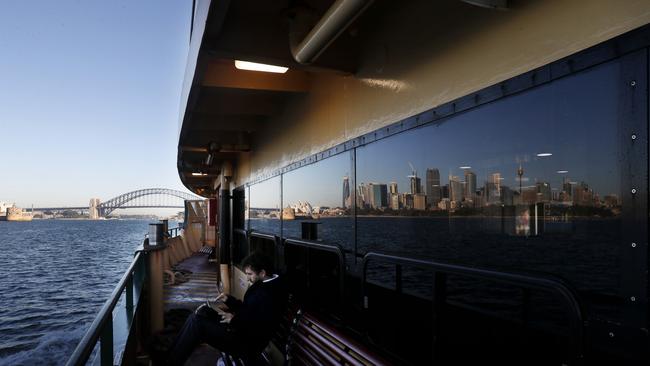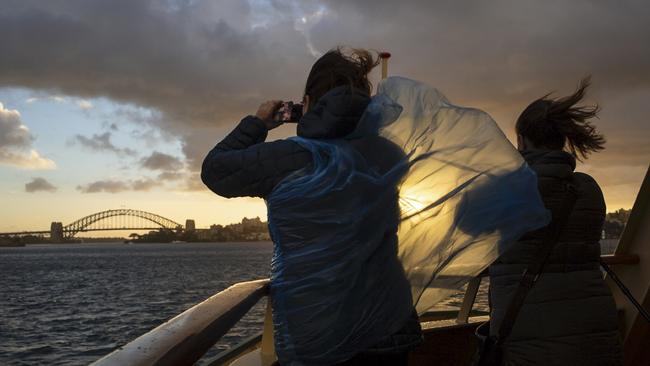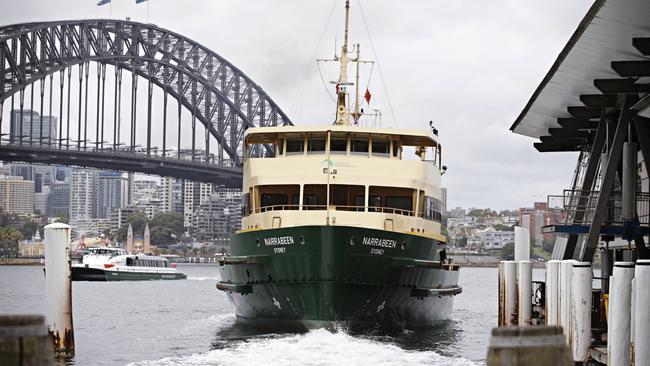Why the old Manly ferries are sailing into the sunset
It’s one of the country’s most famous tourist attractions. So why are the days of the old Manly ferry numbered?

On an early summer day, sun shining over the Emerald City, a welcoming glint bouncing off the gently moving waters of Sydney Harbour, a Covid-friendly crowd of day trippers is gathered at Circular Quay. It’s 10am, well past the old morning rush, and despite lingering social restrictions there’s an unexpectedly festive air among those chatting in small groups, daypacks easily outnumbering not yet mandatory face masks as they wait to board the next ferry to Manly.
Not so long ago, 1000 people would have been crammed onto this city wharf for the 30-minute ride aboard one of four oversized Freshwater class ferries, “the much loved legends of the harbour” according to Transdev, which runs the vessels for the State Government. It’s a stunning trip past some of the city’s greatest sites, plus a few minutes of rock and roll courtesy of the crossing of Sydney Heads, where the harbour opens to the Pacific Ocean.
For 170 years ferries have plied this route past bushland and beaches, public and private mansions, a spectacular still life revealed at each turn. In a real estate-mad city where views are revered, this has become an iconic trip, not just because of the waterfront sites it skirts – the Opera House, the Sydney Harbour Bridge, Fort Denison, and the official Sydney residences of the Prime Minister and the Governor-General – but for the journey itself.
“There’s a romanticism, there’s a wonderment and a sheer joy,” says long-time Manly resident and former NSW premier Mike Baird, who would delight in the slow ride home on a multi-tiered Freshwater in the years he worked in the CBD. “It’s what connects you to the city but, probably more importantly for the locals, it’s what takes us home,” he says. “And if you were on the 6.20 [from Circular Quay] there was a club that used to pull out beers at the back; I was a covert participant.”
Feted in the 1920s as the nation’s premier seaside resort, Manly, the oceanside suburb edged by the harbour, was touted for decades as being “seven miles from Sydney but a thousand miles from care”. But it’s the references in Australian Crawl’s 1983 song Reckless that remain most evocative for Baird:
Meet me down by the jetty landing
Where the pontoons bump and spray
The others reading, standing
As the Manly Ferry cuts its way to Circular Quay
As Baird says: “The experience of pulling out on the Manly ferry as it cuts its way to Circular Quay, Aussie Crawl style, that’s a part of who we are.”
So when, on this early summer day, the gates of wharf three at Circular Quay open, there’s a palpable sense of deflation. Waiting to take passengers across the harbour, on what has consistently been rated as one of the world’s best ferry trips, is not one of the large and characterful Freshwater vessels, with their abundance of outside seating running down both sides and at each end. One of them is temporarily out of action, so a smaller, squat catamaran, with seating mainly inside, is there instead. “What a pity,” an elderly woman says glumly to her companion as they move inside, the doors shut, ropes are untied, and the small vessel makes a U-turn, passes the Opera House, turns right at the Harbour Bridge and heads north-east.
Since the late 1800s, the boats that have moved passengers between Manly and the city have shared several features. While there’s been a succession of classes thanks to maritime improvements, all have been monohulled, smoothing the often rough passage across the heads, and double-ended, which makes manoeuvring the vessels that much easier as they can be skippered from either end without the need to back into or out of a berth. The prize for passengers has been an equally spectacular vantage point from bow or stern, on upper and lower decks. Along the way, these boats, with the feel of a small ship, have become emblematic of the city’s most treasured journey.
This morning’s trip follows the same route, passes the same landmarks, and is stroked by the same sea breeze. But there’s a plodding sense to it. Views on the catamaran are comparatively restricted, and inside it feels much more confined. If you’d never ridden this route you would still be thrilled. But for those who know it even moderately, it’s a harbinger of unwelcome change.

Everyone seems to have a preference on the Freshwater class ferries: upstairs or down, front or back, inside or out. To this side there are the magnificent waterfront homes of the eastern suburbs. To the other there are beaches and bush tracts. Even the direction counts. On the trip to Manly, the northern edge of the harbour offers the zoo and Balmoral Beach. On the return leg, the ferry rounds Bradleys Head to reveal the money shot: a full frontal panorama of the city skyline with all its famous landmarks. Cameras always whirr madly at this point, even in pandemic times when passenger numbers are a fraction of a year ago. There’s a reassuring pattern to the journey: engines thrumming, waves breaking, buoys bobbing, a stiff breeze, the passing parade of nudist beach, naval base and tug boats.
“This is one of the world’s biggest tourist attractions,” says Candy Bingham, a third-generation Manly resident and the area’s deputy mayor, as she sits on a ferry that, due to border closures, is virtually devoid of overseas tourists. She is on the slow boat to Circular Quay, perched in her preferred spot on the upper level of the Queenscliff, one of four Freshwaters launched in the 1980s.
Leaving every half-hour from early morning until past midnight, it’s the city’s most popular route. Before the country was closed, a million international visitors would take this ride every year, clamouring for one of the 1100 spots and snapping endless selfies. A privately run fast ferry service, introduced a decade ago, makes the journey in around 20 minutes and is increasingly preferred by commuters. But it’s the slower trip aboard a Freshwater that is renowned.

“Enjoy your journey on Sydney’s famous Manly Ferry,” a large sign welcomes passengers. But time is clearly rushing past these 40-year-old-vessels. The overhead roof edge is rusting. The balustrade is patchy and needs polishing. And while passenger numbers are up on even a week ago, they are nothing like the pre-Covid peaks. Eighty thousand people were ferried to Manly on Australia Day in 2019, and a quarter of a million made the journey over the Easter long weekend a few months later.
Yet overall, patronage on the route is failing. Between 2017 and 2019, 800,000 fewer trips were taken, a decline of around 15 per cent. A frequent double decker bus service, introduced in 2017, is moving more people between the city and the northern beaches, and the popularity of the fast ferry among commuters is further eroding patronage. Perhaps the biggest issue, though, is that the Freshwaters are ageing. The largest of the harbour’s fleet, they’re approaching the end of their lives. A major service is required every five years and costs between $3m and $5m per ferry. In 2021, three of the four Freshwaters are due for that costly overhaul.
Faced with a balance sheet that favours practicality over sentimentality, the State Government last year announced it would retire the route’s workhorses. The oldest continually serving vessels in the fleet, they would be phased out in the second quarter of 2021 and replaced with a series of smaller, faster and more energy-efficient Emerald class vessels. The compact catamarans will make the trip in just 20 minutes, with capacity for only 400 passengers but the promise of more regular runs – and savings of around $6m a year. They can also be serviced for a fraction of the price and cost half as much to operate per hour. “Commuters particularly are looking for a faster, more frequent service,” transport minister Andrew Constance told reporters when the decision was announced.

In a world forever chasing time, a faster trip ought to have been an easy pitch. But the response has been outrage. “People don’t want to get here quickly,” insists Bingham, who is leading a campaign to preserve the slow old ferries for at least another few decades. “Have you been to San Francisco? What’s one of the first things you do? Catch a cable car. You go to London, one of the first things you do is get on the double decker red bus… Sydney is the Opera House, Bridge and a trip on the Manly ferry. That’s Sydney. It’s not a fast ferry.”
Visitors are crucial to Manly. The $500m they contribute to the local economy is “largely based on the fact that people come to Manly on the ferry,” says Bingham. “It’s really our lifeblood.” Before Covid, more than four million people travelled from Circular Quay annually, many of them crowded in on weekends and public holidays. Take away the classic ferry and Bingham fears much of the attraction of a visit will have been eroded. “The Emerald class, they are just like every other ferry on the harbour. People can jump on a ferry and go to the zoo or Watsons Bay. Why go to Manly?”
Should they opt for Manly anyway, Bingham says that the much smaller replacement vessels will be unable to cope with the normally huge numbers across the busy holidays and summer. “What’s concerning me is that the government is just focused on the commuter,” she says. “They [Freshwaters] are part of our heritage.”

That sentimentality is proving difficult to resist, even for a once forthright state government. After a community outcry, Constance announced late last year that the youngest Freshwater class ferry, the Collaroy, would be retained until at least 2023 – but only that one vessel and only for weekends and public holidays. Everyone else could ride the Emerald class. In January, he announced that a second ferry, the Freshwater, would be retained on a similar reduced basis as a result of community feedback. “But that will be it,” a spokesperson insisted.
Unsurprisingly, not everyone is happy with that idea. “It’s a drawcard to bring in tourists because they cross the ocean past the heads,” says ferry historian Bill Allen, who is aware of the emotions attached to the debate over replacing older and bigger with newer, smaller and faster. Still, he’s concerned about any of the old ferries remaining in operation past their use-by date. “You wouldn’t want to fly to London in a 40-year-old plane,” he says.
The alternative, however, like the problem, is not straightforward. Even with strengthened hulls, Allen worries that one of the most exciting parts of the trip will potentially be rendered its most despised. “Catamarans are built for speed, lightweight, and that’s what they are good at. But as a sea boat… You wouldn’t want to be going across the heads in a catamaran.”
But that’s probably the future for Sydney’s most cherished trip. Even with two of the big ferries being retained for weekend use, they are unlikely to be around for long. (An exact retirement date has not been announced.) “This [Freshwater class] is about history, it’s about stories, and I think it adds hugely to the beauty of the harbour,” says Mike Baird, who as a newish MP also supported moves for a fast ferry to and from Manly. “Obviously when you’re in work mode the 18 minutes is great. But at the same time I used to get a [slow] ferry because it’s the chance to recalibrate your thoughts for the day.” Will he miss the Freshwaters? “Terribly. And I know many in the community who will.”
Progress can be an emotional inevitability. Time may be all but up for the old ferries, but it’s timing that’s dogging their replacements. “The trip will be probably 10 minutes quicker,” says Allen of the catamarans that are likely to provide the ride of the future. “Is 10 minutes really worth it?”


To join the conversation, please log in. Don't have an account? Register
Join the conversation, you are commenting as Logout